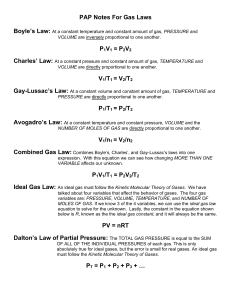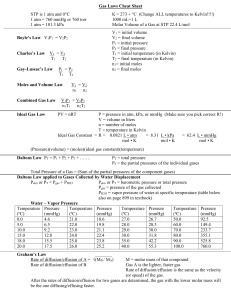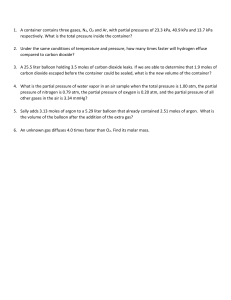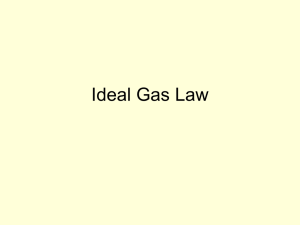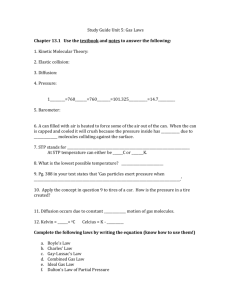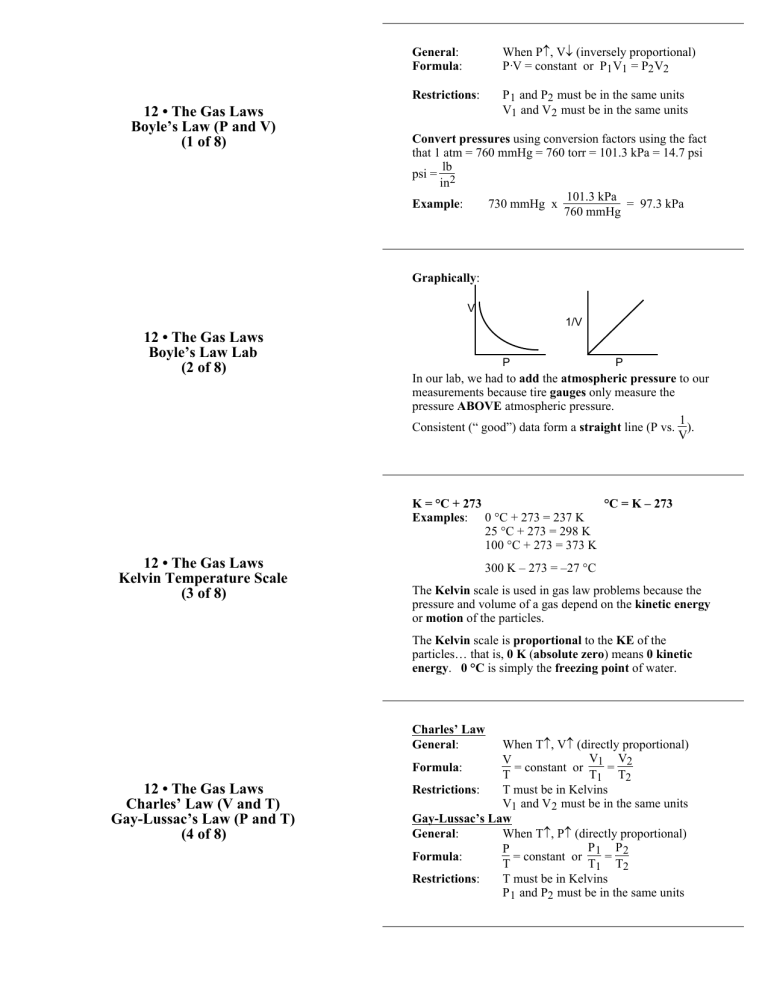
12 • The Gas Laws Boyle’s Law (P and V) (1 of 8) General: Formula: When P↑, V↓ (inversely proportional) P·V = constant or P1 V1 = P2 V2 Restrictions: P 1 and P2 must be in the same units V1 and V 2 must be in the same units Convert pressures using conversion factors using the fact that 1 atm = 760 mmHg = 760 torr = 101.3 kPa = 14.7 psi lb psi = 2 in 101.3 kPa Example: 730 mmHg x = 97.3 kPa 760 mmHg Graphically: V 1/V 12 • The Gas Laws Boyle’s Law Lab (2 of 8) P P In our lab, we had to add the atmospheric pressure to our measurements because tire gauges only measure the pressure ABOVE atmospheric pressure. 1 Consistent (“ good”) data form a straight line (P vs. ). V K = °C + 273 °C = K – 273 Examples: 0 °C + 273 = 237 K 25 °C + 273 = 298 K 100 °C + 273 = 373 K 12 • The Gas Laws Kelvin Temperature Scale (3 of 8) 300 K – 273 = –27 °C The Kelvin scale is used in gas law problems because the pressure and volume of a gas depend on the kinetic energy or motion of the particles. The Kelvin scale is proportional to the KE of the particles… that is, 0 K (absolute zero) means 0 kinetic energy. 0 °C is simply the freezing point of water. Charles’ Law General: 12 • The Gas Laws Charles’ Law (V and T) Gay-Lussac’s Law (P and T) (4 of 8) When T↑, V↑ (directly proportional) V V V Formula: = constant or 1 = 2 T T1 T2 Restrictions: T must be in Kelvins V1 and V 2 must be in the same units Gay-Lussac’s Law General: When T↑, P↑ (directly proportional) P P P Formula: = constant or 1 = 2 T T1 T2 Restrictions: T must be in Kelvins P 1 and P2 must be in the same units Formula: Restrictions: 12 • The Gas Laws The Combined Gas Law (5 of 8) P ·V P ·V P·V = constant or 1 1 = 2 2 T T1 T2 T must be in Kelvins V1 and V 2 must be in the same units P 1 and P2 must be in the same units STP (“standard temperature and pressure”) is often used as one of the two conditions T = 0 °C = 273 K P = 1 atm = 760 mmHg = 101.3 kPa Each of the three gas laws is really a special case of this law. Example: If T1 = T2 , the law becomes P1 V1 = P2 V2 Formula: where 12 • The Gas Laws The Ideal Gas Law (6 of 8) 12 • The Gas Laws Dalton’s Law of Partial Pressure (7 of 8) P·V = n·R·T or PV = nRT P = pressure V = volume n = number of moles R = the ideal gas constant T = temperature (in Kelvins) The value of R depends on the P and V units used. PV R= so you can use the molar volume info to calculate R nT (101.3 kPa)(22.4 L) L·kPa R= = 8.31 (1 mole)(273 K) mol·K L·mmHg L·atm R = 62.4 = 0.0821 mol·K mol·K When you have a mixture of gases, you can determine the pressure exerted by each gas separately. This is called the partial pressure of each gas. Since each gas has the same power to cause pressure (see card #8) the partial pressure of a gas depends on how much of the mixture is composed of each gas (in moles) Example: Consider air, a mixture of mostly O2 and N 2 P O2 P N2 moles O 2 moles N 2 = = moles total P total moles total P total Also: P total = P O2 + P N2 This idea is used when a gas is collected over water P atm = P gas + P H2 O P H2 O is found on a chart The gas laws work (to 3 significant digits) for all gases… that is, all gases have the same power to cause pressure. 12 • The Gas Laws Why Do All Gases Cause the Same Pressure? Graham’s Law (8 of 8) At the same temperature, the KE of each gas is the same. KE = 1 /2 mass·velocity2 … if two particles have different masses, their velocities are also different. So… SMALL particles move FAST LARGE particles move SLOWLY v2 m m v2 We can use this idea with numbers as well: (Graham’s Law) KEA = KEB mAvA2 = mBvB2 [another version of this formula is on pg 323 of the text]

